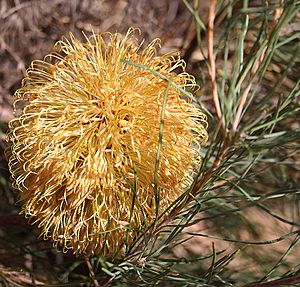Banksia subser. Leptophyllae facts for kids
Quick facts for kids Banksia subser. Leptophyllae |
|
|---|---|
 |
|
| Banksia leptophylla (Slender-leaved Banksia), the type species of B. subser. Leptophyllae | |
| Scientific classification | |
| Kingdom: | |
| (unranked): | |
| (unranked): | |
| Order: | |
| Family: | |
| Genus: | |
| Subgenus: | |
| Series: | |
| Subseries: |
B. subser. Leptophyllae
K.R.Thiele
|
Banksia subser. Leptophyllae is a scientific name for a special group of Banksia plants. Think of it like a smaller family within the larger Banksia genus. This name was first used by a scientist named Kevin Thiele in 1996. However, another scientist, Alex George, decided not to use it in his plant classification system in 1999.
Contents
How Scientists Group Plants
Scientists often use a method called cladistics to figure out how different plants are related. It's like building a family tree for plants! They look at shared features to group plants together. This helps them understand the phylogeny, which is the evolutionary history of a group of organisms.
Thiele and Ladiges' Study
In 1996, Kevin Thiele and Pauline Ladiges did a detailed study of Banksia plants. They created a "cladogram," which is a diagram showing how plants are related. Their findings were a bit different from how Banksia plants were usually grouped.
Their study showed a main group, called a clade, that was very similar to what Alex George called Banksia series Abietinae. This main group then split into four smaller groups, or subclades. Thiele gave each of these four subclades a new subseries name. Banksia subser. Leptophyllae was the name for the fourth of these smaller groups.
This is how the plants in this group were related according to their study:
|
|||||||||||||||||||
What Defines This Group?
Banksia subser. Leptophyllae was officially described by Thiele and Ladiges based on specific features. Plants in this group have:
- Indurated and spinescent common bracts: This means they have tough, spiky leaf-like parts on their old flower spikes.
- Densely arachnose seedling stems: Their young plant stems are covered in a thick, cobweb-like fuzz.
The name Leptophyllae comes from the Banksia leptophylla plant, which is the main example for this group. Leptophylla means "slender-leaved" in Greek. This name was chosen because the plants in this subseries have long, narrow leaves, which are thinner than most other Banksia species in the Abietinae series.
Where it Fit in Thiele and Ladiges' System
In Thiele and Ladiges' classification system, Banksia subser. Leptophyllae was placed within the larger Banksia series Abietinae. Here's a simplified look at where it fit:
- Banksia
-
- B. subg. Banksia
- B. ser. Abietinae
- B. subser. Nutantes (1 species, 2 varieties)
- B. subser. Sphaerocarpae (4 species, 2 varieties)
- B. subser. Leptophyllae
- B. telmatiaea
- B. scabrella
- B. leptophylla
- B. leptophylla var. melletica
- B. leptophylla var. leptophylla
- B. lanata
- B. subser. Longistyles (6 species, 2 varieties)
- B. ser. Abietinae
- B. subg. Banksia
-
However, Thiele and Ladiges' system was only used for a short time. In 1999, Alex George published his own updated classification for the Flora of Australia book series. He looked at some of Thiele and Ladiges' information but decided not to use their overall arrangement. Because of this, Banksia subser. Leptophyllae and the other subseries within Banksia series Abietinae were no longer officially recognized.
New Discoveries
Since 1998, another scientist named Austin Mast has been doing his own studies using DNA sequence data. This means he looks at the genetic information of plants to see how they are related. His findings suggest a plant family tree that is quite different from older systems.
Interestingly, Mast's results agree with Thiele and Ladiges' idea for Banksia subser. Leptophyllae. His studies show a group of plants that matches exactly with Thiele and Ladiges' subseries. He found that Banksia grossa (Coarse Banksia) is the closest relative outside of this group.
In 2007, Mast and Thiele started to rearrange the Banksia genus again. They moved another group of plants called Dryandra into Banksia. They also created a new subgenus called Banksia subgenus Spathulatae for plants that have spoon-shaped cotyledons (the first leaves that appear when a seed sprouts). All the plants that were once in subseries Leptophyllae now belong to this new subgenus. Mast and Thiele plan to publish a complete new arrangement once they finish studying the DNA of all Dryandra species.

